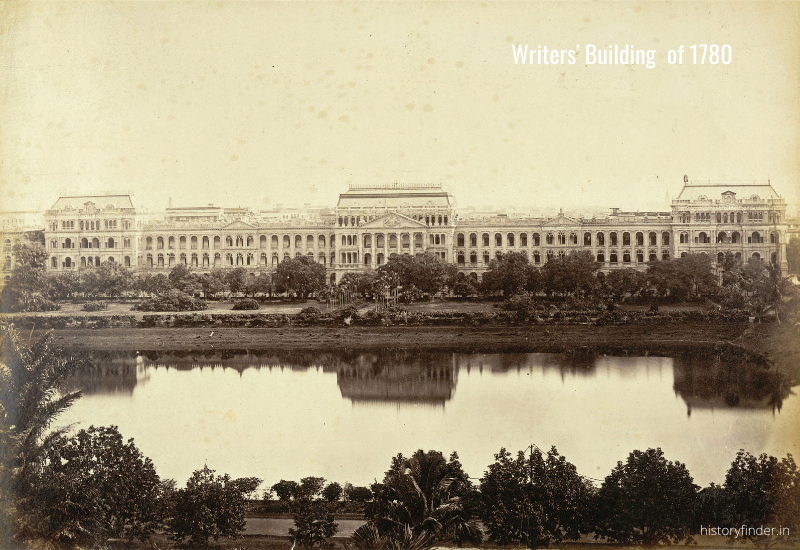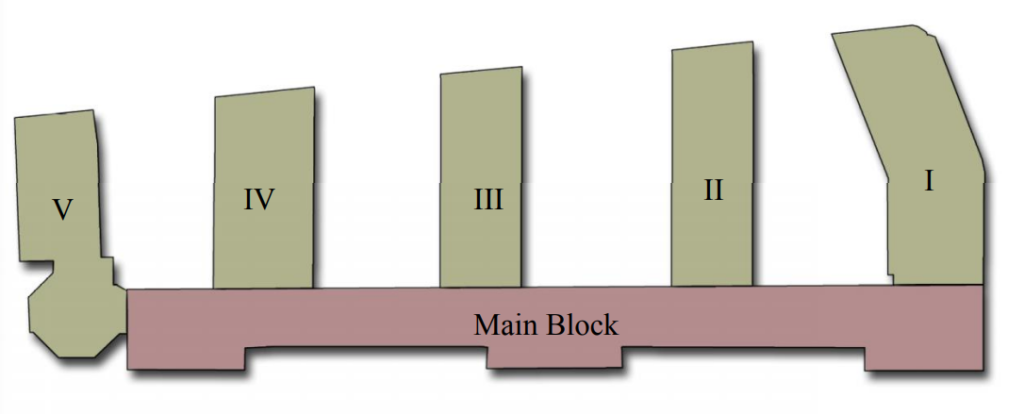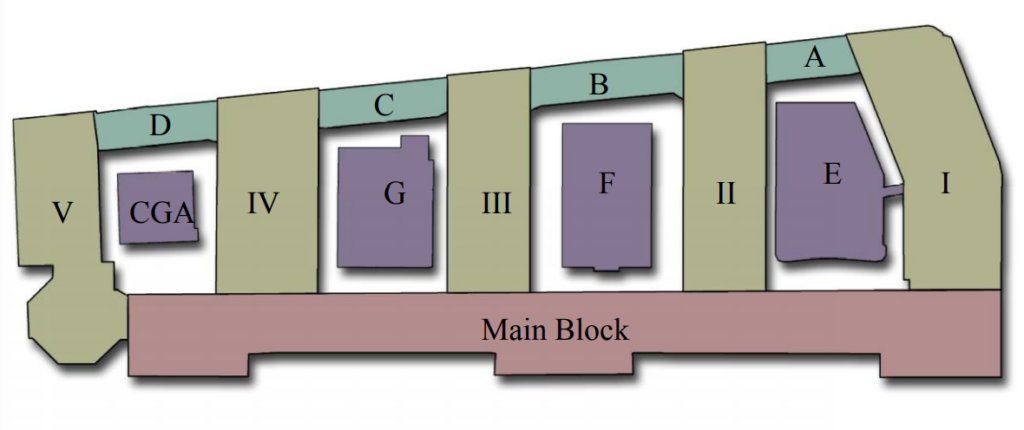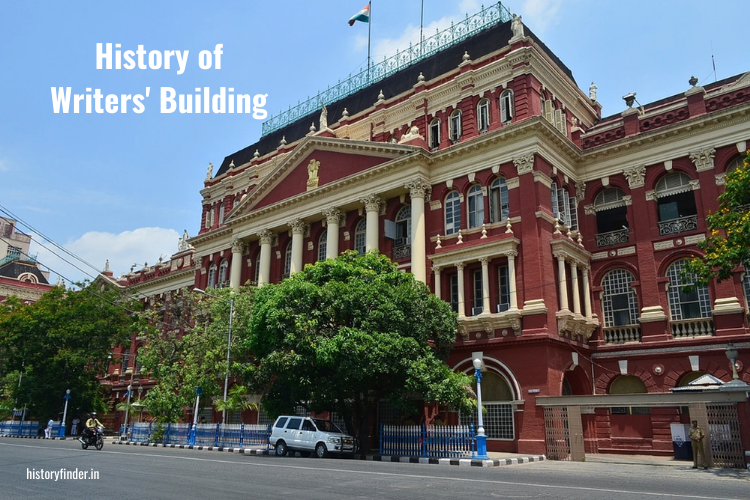Writers’ Building is undoubtedly one of the few amazing old constructions of Kolkata. Located the BBD Bagh (formerly Tank square and Dalhousie square) area, the building has a stunning view with Lal Dighi. The iconic facade of Writers’ Building including the 128ft long veranda and 32ft high yellow columns still attract many tourists. Writers’ now serves as secretariat of West Bengal state government, however temporarily closed for repair works. How a living place of the writers’ became the secretariat of government is worth knowing to the history lovers. Not only that, the building has witnessed numerous historical events and transformation of Kolkata for past 240 years.
The junior clerks of British East India Company (EIC) were often called as writers. Construction of this building was planned to accommodate their administrative office and living place as well. Henceforth the name became the Writers’ Building. People of West Bengal, often shortens the name further as just Writers’. The building also has a second identity as ‘Mahakaran’.
Mahakaran’s initial look was nowhere near to it’s present day appearance. First considerable visual illustration of Writers’ is found from the painting by Thomas Daniell. The British landscape painter had visited India in late 18th century and spent few years here.

History of Writers’ Building Kolkata
Initial construction
Initial two storied construction was completed in 1777. But in 1980, another floor was added to it. Writers’ Building then became the first three storied building of Kolkata. The 150 meter long building, had a great look with iconic Lal Dighi in front of it.

Earlier, St Anne’s Church was occupying the place. However, the church was demolished before the construction of Writers’ had started. The land of the church and it’s adjoining plots were allotted for the construction. Thomas Lyon, a British carpenter turned builder designed the building. Lyon finished the construction work on behalf of it’s owner, Richard Barwell.
During the first phase of construction between 1777 and 1780, only the main block was erected. The remaining thirteen blocks were added in different phases of construction.

Takeover by EIC
During late 18th century, East India Company (EIC) started looking to centralize all it’s tax operations in Mughal Bengal. So, it needed an administrative office to implement that. Warren Hestings, the acting governor of EIC then, who planned and also presided the construction of Writers’ Building Kolkata.
Hestings was also a good friend of Richard Barwell. He (Barwell) was member of supreme council of Bengal and also an ex-writer of EIC. So, looking for an office and living place for the writers, Hestings took the leading role to commission the Writers’. However, EIC took over the property on lease in 1780.
Structural changes at Writers’ Building Kolkata
As the requirements changed, the Writers’ also had gone through several structural changes. First two decades, the building served as the administrative office and living place for the junior clerks (writers) of EIC. Initial structure consisted of 19 residential quarters. Each quarter had three sets of windows.
In next three decades, it became an educational hub for European students for learning oriental languages.
Fort William college
In 1800, when Fort William college were moved in to the building, it became an academy for oriental studies for European administrators. It brought a number of structural changes to the Writers’. New constructions like libraries, lecture halls, exam halls took place during this period. It further extended with an addition of a hostel that could accommodate of 32 students. These constructions still exist at present day.
The college continued for three decades here. In 1830, after Fort William college were moved out of the building. It went into the hands of private owners, who eventually turned it into a place of shops, godowns and living places.
The iconic facade
Added in 1821, the iconic facade of Writers’ building still is carrying the building’s identity for past 200 years. The addition included a long veranda on the first and second floor and six tall columns to support it. Those 32 feet tall yellow columns with a prominent red brick wall at the back makes the building noticeable even from a distance.
Headquarter of Eastern Railway Company had occupied a significant part of the building between 1871 and 1874.
Secretariat of Bengal Province
Until 1911, former Calcutta remained the capital of British India. British administration desperately needed to form a secretariat for their operational ease. Firstly, principal offices were shifted to Writers’ Building in 1877. But with only the main block constructed, EIC faced massive space crunch to accommodate other offices. It triggered out the second phase of construction which consisted addition of blocks I, II, III, IV & V to the main block.

Statues of the Writers’
The construction continued for almost three decades (1879 – 1906). Writers’ got it’s Greco-Roman look in 1883 when the edifying statues were installed. The terrace contains several statues. Four of them are really noticeable christened as ‘Justice’, ‘Commerce’, ‘Science’ and ‘Agriculture’. Each of them represents the Greek gods and goddesses of respective disciplines. The giant statue of Minerva was placed to mark the symbol of law and justice. Addition of the iconic parapets also had great significance in final makeover of the building.

Third phase of construction
Space crisis kept increasing with time. As a mitigation process, third phase of construction started in 1945 with a plan to add blocks A, B, C and D to the existing blocks. The construction process continued till 1947.

The secretariat of the State of West Bengal
After India achieved independence in 1947, the Writers’ continued to serve as the secretariat for the state government. But the space crunch continued to increase. Hence the state government later added four more blocks in two phases. Firstly, blocks E and F were added during the decade of 1950s. Addition of blocks G and CGA commenced during the decade of 1970s concluded the present avatar of Writers’.

Assassination of Lt. Colonel Simpson
Lt. Colonel Simpson was infamous for his brutality towards the Indian prisoners, especially the freedom fighters. The revolutionary organization of Bengal hence decided and planned to eliminate Simpson. Three young members of the rebel organization in Bengal: Benoy Basu, Badal Gupta and Dinesh Gupta shot Simpson dead from a point blank range on 8 December 1930. But soon found themselves overpowered and cornered by the security forces of the building.
Unwilling to surrender, all committed suicide. Badal took potassium cyanide and died on the spot. Benoy and Dinesh shot themselves and was taken to hospital seriously injured. Benoy died in hospital in five days. Dinesh survived in hospital but court gave him a death sentence and was finally hanged on 7 July 1931.
The State Government of West Bengal later honored these three martyrs and renamed the Dalhousie Square as BBD Bag (Benoy Badal Dinesh Bag). Government also installed a statue of Benoy, Badal and Dinesh in front the Writers’ Building.

Final takeaways
The Writers’ Building Kolkata or Mahakaran had been a hallmark of law and justice for centuries. Until taken under renovation plan in 2013, it continued to house the office of the Chief Minister and other cabinet ministries. As the secretariat has temporarily been shifted to Nabanna building, the present importance of the building has decreased slightly. But not the historical significance the Writers’.
The building is called a small township for a reason. So, the renovation work is always bigger than the imagination. However, some of the state ministries are still functional from Writers’. According to a report published in 2021, renovation of main block along blocks II and III were mostly finished. Group of expert architects and engineers are working hard to bring back the glory days of Writers’ Building soon.

Pingback: History of Kolkata: discovery to independence - History Finder